The Soft Swimbait Revolution
By Bryan Blazek – Date Posted: May 11, 2011
Many advances in technology have changed the way we collectively view fishing tackle and artificial baits. The most influential factor that often contributes to innovation is new synthetic compounds used for materials that are the products of an increasing technology driven market.
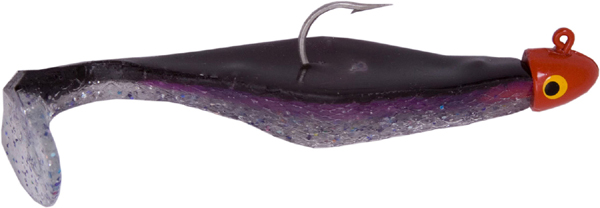
One only has to take a quick look at the evolution of the golf club, for instance, to realize the way materials and new technology driven designs have changed an entire sport. Fishing may be less affected than golf by these advances; however, it is affected nonetheless. The advances in technology and materials have created a plethora of new bait and tackle options, with some artificial baits offering lifelike realism and swimming characteristics that were previously unattainable.
I’m not here today to talk about fancy high modulus graphite composites in our rods, or alloys that make our reels lighter. I am not even here to talk about fluorocarbon and braided lines that have made some fishermen regard mono-filament as a thing of the past. What we are here today to examine is the evolution of the swimbait, from their humble west coast and saltwater beginnings, to the versatile multi-species tools they have become today.
Early Swimbaits
Sometime in the late 1970’s and early 80’s, soft plastic shad baits were appearing on the fishing tackle market. The baits were characterized by a paddle tail and a shad profile that is still found today on baits such as the Mister Twister Sassy Shad. This venerable design has found a place in the market mostly among light tackle saltwater, as well as walleye anglers. The smaller size Sassy Shad is still a very effective multi-species river tool for everything from smallmouth bass to walleye and pike, and carp of many varieties.
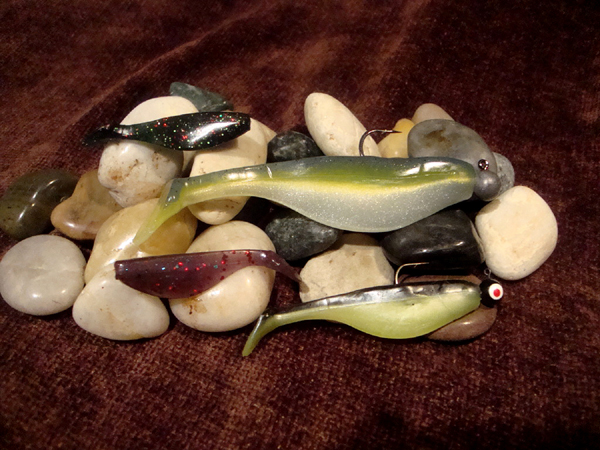
The original shad bodies were made of a much less flexible soft plastic, therefore they often required heavy jig heads and deep water to impart the action on the lure. Because of these two reasons alone, these shad bodies were often disregarded by all but a few west coast bass anglers. The Sassy Shad has been catching fish since the early 1980’s, but many anglers fail to realize it may be the grandfather of many of the modern swimbaits on the market today. The tail action that these lures create with their large paddle tails not only provides an ultra-realistic swimming action, but also a noticeable vibration to stimulate the target fish’s lateral line.
Second Coming
Shortly after this, around the early 1990’s, Alan Cole of AC Plug Swimbaits, largely considered the ‘father’ of the swimbait, and a former Fishing-Headquarters sponsor in 2008-2009, began testing a prototype of a huge new rainbow trout swimbait. Stocker size trout had become the main forage for large bass in California reservoirs, and Cole planned capitalizing on this by crafting meticulously detailed swimbaits that recreated the look and swimming action of the fish they were modeled after.
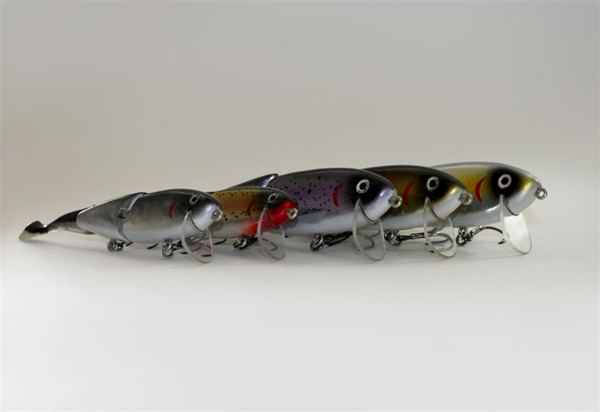
This new bait was an instant success, spurring a number of similar designs from big name manufacturers. These baits were beautifully designed and painted. However, they were much too large and application specific to be widely accepted among the bass fishing community. Again, the common feature in the high quality giant baits was usually a large paddle tail. In recent years, however, these lures have been adapted to fish every depth with combinations of hard and soft plastic construction and other significant advances.
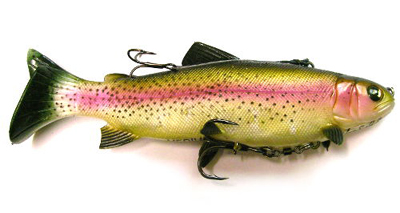
Brand new, for the very third time.
In 1996, a California company, Optimum Baits, began producing hand poured swimbaits with insider jig heads. Optimum’s design allowed for precise control over the action the hook and weight imparted on the lure, as well as taking the responsibility of rigging the bait out of the fisherman’s hands. This was a huge innovation, and many other companies quickly followed suit, as is the case with any tackle innovation.
There are many companies still manufacturing this style swimbait, further innovating on the appearance with complex paint schemes and extremely detailed molds. Looking at some of the modern insider head swimbaits is often like staring at an exact soft plastic replica of the bait fish, but again with a paddle tail and ultra soft plastic for realistic swimming action and lateral line stimulation. Some companies have gone so far as to add rattle chambers as well, for an ultra shad-like sound. Below are a few examples of the modern renditions of the insider jig head swimbait.
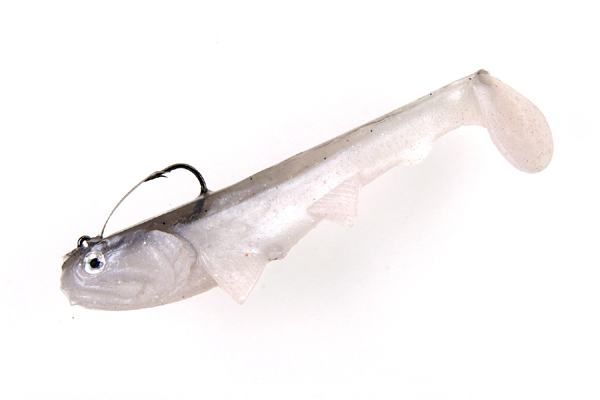
Modern Swimbaits
The revolution of the modern swimbait is most definitely attributed to advances in computer technology, as well as advances in manufacturing techniques. In the late 2000′s, many hollow bodied swimbaits started showing up on the store shelves of tackle outlets, initially in 5 inch followed by 3.5 inch varieties. This, in turn, made a huge impact on the use of swimbaits as a bass catching tool for anglers in the majority of the country, where these sizes more accurately represent the bait fish forage size for large and small mouth bass we encounter.
These are very effectively rigged on specially designed swimbait hooks with screw type bait keepers and belly weights. This style of rigging allows for a very natural swimming action, as well as weed resistance. Some companies have also added a fluttering blade beneath the hook for added flash. These hook designs are able to incorporate a screw type bait keeper, but you can get a slightly different action by using a belly weighted standard EWG hook. Rigging with this hook can be good for ultra thick grassy situations where you want an ultra stealth entry in and out of cover.
In addition, there has been a recent innovation adding a belly slit to these baits, making rigging an easier chore. These style baits can also be fished on a ball head or mushroom style jig head, my preferred method for smallmouth bass fishing on rivers.

Though one side of the market was concentrated on hollow body swim baits, the folks at Optimum were not content, and went to work on further innovating their corner of the swimbait market. In an interview with Matt Paino, CEO of Optimum Baits, Matt stated “The swimbait market has seen a surge in hollow body swimbaits over the past couple of years. At Optimum we focused on our Line Thru swimbaits, which were a variation of our Suspending Optimums, as well as the Double Diamonds.” Optimum Baits capitalizes on computer aided design processes both in the modeling and manufacture of their molds, as well as actually swimming the bait in a cyber platform in order to create a distinct action in their baits. He further explains, “Technology speeds up everything and allows you to make more changes freely. Before when masters were carved or molded it was extremely time consuming and costly to start over from scratch. Now we can have 3 slightly different designs created on one rapid prototype and can narrow the necessary changes down real quickly.”
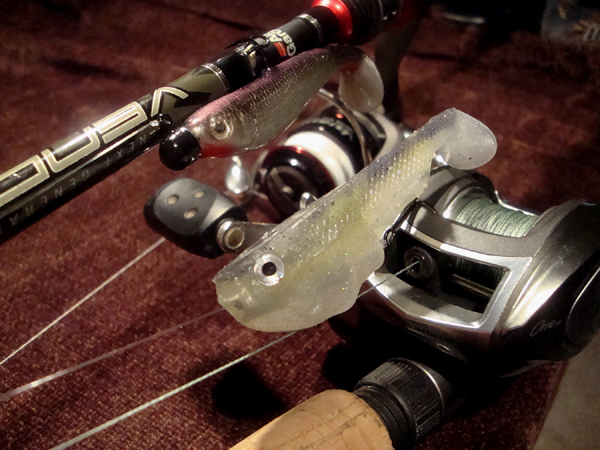
Paino concludes, “Optimum’s key focus on creating the Double Diamond was the action of the bait. That’s why Optimum turned to a computer-aided design and a simulation program that would virtually ‘swim’ the computer model of the Double Diamond through all possible water flow simulations representing the fresh and saltwater scenarios where the Double Diamond would be used, thereby enabling Optimum to fine-tune the hydrodynamic swimming actions of the Double Diamond shape until perfect.”
The Double Diamond style bait is so significantly different than many other baits, I thought it would be a good idea to discuss all available rigging options, as there are a couple you normally wouldn’t think of, and this can be where this bait truly shines.
First of these would be the weightless rig. Simply rig it texas-style on an EWG hook. This is not possible with most baits due to their propensity to roll over. Despite the issue, the hydrodynamic stability of this bait that was gained in the design process allows for this and Carolina rigging options. That’s right; rig one on a Carolina rig for an ultra wide zig-zag action at depth. I could see this as an effective way to present in grass flat situations, as well as for fishing their Goby patterned bait for smallmouth bass on Lake Michigan.
Lastly you can Texas rig one with a bullet sinker, if you are the guy who wants ultimate soft bait versatility without ever changing your hook. All of the traditional swimbait hooks are also applicable here. Optimum has also recently developed a line-though swimbait that utilizes a single treble hook, and rides up the line when a fish is on to reduce the chances of being torn or lost; all while remaining a hand poured soft bait.
Do the jig.
Do you like fishing a swim jig? Adding a paddle tail bait to your swim jig adds a different look to the bait, and may be just the ticket when the grub isn’t doing the job. Adding a bait like the Double Diamond will even add a side to side wobble to your jig.
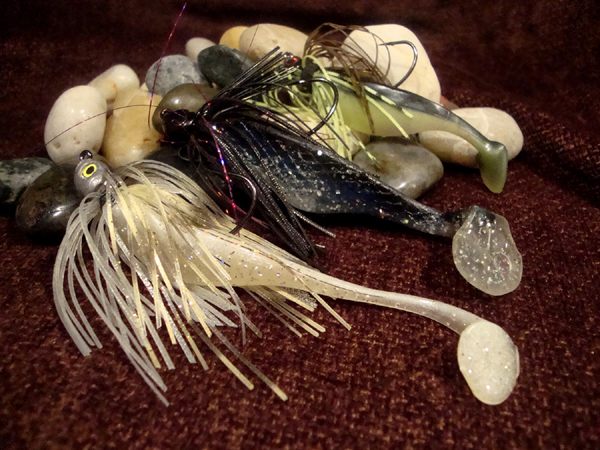
Gear Up
Ultimately the responsibility lies with the angler to select the bait and rigging method that most closely imitates the available natural forage. It is very important to establish the available natural forage when selecting a bait in order to ‘match the hatch’. With all of the various spawning seasons throughout the spring and summer in ponds, lakes, and rivers, it is important to know what bass and possibly other large predatory species are feeding on. Many professional anglers will turn to a 5 inch swimbait to seek out larger fish once they have a limit, because these baits are known to catch some big bass. For instance, this is exactly what Skeet Reese did in April 2010 to win at Virginia’s Smith Mountain Lake Bassmaster Elite Series event with an astonishing three day weight of 78 lbs. Reese focused his efforts on big fish in shallow water, throwing Jerry Rago swimbaits to close shoreline quarters.
Personally I have had the most success retrieving swimbaits at a good speed, remembering that bait fish move fast, especially when there’s a big bass around. I make long casts, with a constant fast retrieve. The occasional jerk, or dead pause is often what it takes to get a curious bass to strike. You can cover all depths with soft paddle tail style swimbaits, but they can be a good search tool in order to establish a pattern or find fish.
The beautiful thing about these baits is none of them are more than 5/8 oz. in total weight. They are effectively fished on a 6 ft. 6 in. medium heavy rod. Either spinning or baitcasting outfits are fine, but I definitely prefer a baitcaster for everything larger than 3.5 inches. For lighter baits, I use 14 lb. braided superline with a 3 ft., 10 lb. fluorocarbon leader. For the heavier baits I often use a combo of 40/15, braid/fluoro, starting with the same 3 ft. leader length. Sometimes I tie my leaders even longer; this is not for stealth, but so I can retie a few times without tying additional leaders. If you are fishing particularly deep water, a fast sinking fluorocarbon line will aid in getting your bait deeper, faster, and stay there. Line choice can be of particular significance when fishing swimbaits, so I would advise to go with the lightest line you think is responsible in order to minimize the affects of wind and current on the bait.




